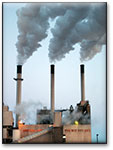|
| |

Mercury contamination is widespread globally, originating from natural and human-related sources, including air transport from coal combustion, waste incineration, and mining.
|
Mercury Emissions from Power Plants
The Bush administration has long attemped to avoid issuing new standards to regulate mercury emissions by coal-fired power plants based on Maximum Achievable Control Technology (MACT), as required by the Clean Air Act.29 Mercury is a neurotoxin that can cause brain damage and harm reproduction in women and wildlife; coal-fired power plants are the nation’s largest source of mercury air emissions, emitting about 48 tons annually.30
As a prelude to the current debate, published accounts to date have documented that senior Bush officials suppressed and sought to manipulate government information about mercury contained in an EPA report on children’s health and the environment. As the EPA readied the report for completion in May 2002, the White House Office of Management and Budget and the OSTP began a lengthy review of the document. In February 2003, after nine months of delay by the White House, a frustrated EPA official leaked the draft report to the Wall Street Journal, including its finding that 8 percent of women between the ages of 16 and 49 have mercury levels in the blood that could lead to reduced IQ and motor skills in their offspring.31
The finding provides strong evidence in direct contradiction to the administration’s desired policy of reducing regulation on coal-fired power plants and was, many sources suspect, the reason for the lengthy suppression by the White House. On February 24, 2003, just days after the leak, the EPA’s report was finally released to the public.32 Perhaps most troubling about this incident is that the report may never have surfaced at all had it not been leaked to the press.
In a more recent development, the new rules the EPA has finally proposed for regulating power plants’ mercury emissions were discovered to have no fewer than 12 paragraphs lifted, sometimes verbatim, from a legal document prepared by industry lawyers.33 Chagrined EPA officials contend that the language crept into their proposed rules “through the interagency process.” But Robert Perciasepe, who headed the EPA air policy office during the Clinton administration, stated the obvious when he called the wholesale use of industry language “inappropriate.” As Perciasepe told a Washington Post reporter: “The regulations are supposed to be drafted by the staff—the people in the science program and regulatory branches.”34
Addressing Multiple Air Pollutants
As an alternative to the president’s Clear Skies Act, Senators Thomas Carper (D-DE), Judd Gregg (R-NH), and Lincoln Chafee (R-RI) have proposed a measure that would control carbon dioxide in addition to sulfur dioxide, nitrogen oxides, and mercury. The EPA has evaluated this proposal but has withheld most of the results from the senators. However, a copy of a briefing based on the study was leaked to the Washington Post.35 According to the briefing, the EPA concluded that the Senate proposal would cut the three pollutants earlier and in larger quantity than the Clear Skies Act, result in 17,800 fewer expected deaths by 2020, and reduce carbon dioxide emissions at “negligible” cost to industry.
The suppression of research on air pollution is of serious concern because of its enormous impact on public health. The Clean Air Act, which passed during the Nixon administration and was strengthened in 1990 during the first Bush administration, has saved American lives. For the period up to 1990, the EPA found that, without the act, “an additional 205,000 Americans would have died prematurely and millions more would have suffered illnesses ranging from mild respiratory symptoms to heart disease, chronic bronchitis, asthma attacks, and other severe respiratory problems. In addition, the lack of the Clean Air Act controls on the use of leaded gasoline would have resulted in major increases in child IQ loss and adult hypertension, heart disease and stroke.”36 In its 1999 study, the EPA projected that in 2010 alone, the 1990 strengthening amendments “will prevent 23,000 premature deaths, and avert over 1.7 million incidents of asthma attacks...67,000 incidents of chronic and acute bronchitis...4.1 million lost work days.”
According to the New York Times, EPA staff members recounted that they discussed the EPA’s unreleased report indicating the advantages of the Carper-Gregg-Chafee proposal at a May meeting with Jeffrey Holmstead, assistant administrator for air programs. As these EPA staffers contend, Holmstead wondered out loud “How can we justify Clear Skies if this gets out?” although he has since stated that he did not “recall making any specific remarks.”37
29 E. Pianin, “White House, EPA Move to Ease Mercury Rules,” Washington Post, December 3, 2003.
30 See “EPA proposes options for signifi cantly reducing mercury emissions,” December 15, 2003. Online at www.epa.gov/mercury/mercuryfact12-15final.pdf. Mercury MACT Proposed Rule and other source material at www.nwf.org/news.
31 J.J. Fialka, “Mercury Threat to Kids Rising, Unreleased EPA Report Warns,” Wall Street Journal, February 20, 2003.
32 “America’s Children and the Environment: Measures of Contaminants, Body Burdens, and Illnesses,” Second Edition, February 2003. Online at www.epa.gov/ envirohealth/children/ace_2003.pdf
33 See E. Pianin, “Proposed Mercury Rules Bear Industry Mark,” Washington Post, January 31, 2004.
34 Ibid.
35 G. Gugliotta and E. Pianin, “Senate Plan Found More Effective, Slightly More Costly Than Bush Proposal,” Washington Post, July 1, 2003.
36 See www.epa.gov/oar/sect812. See also data from the American Meteorological Society.
37 J. Lee, “Critics Say E.P.A. Won’t Analyze Clean Air Proposals Confl icting with President’s Policies,” New York Times, July 14, 2003.
< Previous Next >
|

